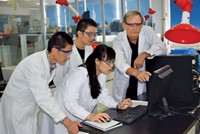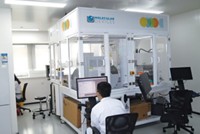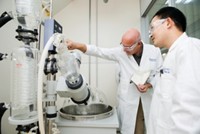Advertisement
Grab your lab coat. Let's get started
Welcome!
Welcome!
Create an account below to get 6 C&EN articles per month, receive newsletters and more - all free.
It seems this is your first time logging in online. Please enter the following information to continue.
As an ACS member you automatically get access to this site. All we need is few more details to create your reading experience.
Not you? Sign in with a different account.
Not you? Sign in with a different account.
ERROR 1
ERROR 1
ERROR 2
ERROR 2
ERROR 2
ERROR 2
ERROR 2
Password and Confirm password must match.
If you have an ACS member number, please enter it here so we can link this account to your membership. (optional)
ERROR 2
ACS values your privacy. By submitting your information, you are gaining access to C&EN and subscribing to our weekly newsletter. We use the information you provide to make your reading experience better, and we will never sell your data to third party members.
Pharmaceuticals
A Triumphant Trio
Chinese scientists who studied together two decades ago in Shanghai enjoy great success in U.S. drug discovery
by Jean-François Tremblay
October 14, 2013
| A version of this story appeared in
Volume 91, Issue 41

The class of 1989 at Shanghai Institute of Organic Chemistry (SIOC), one of China’s top chemistry schools, had just 24 students. Today, two of those former classmates are responsible for cancer drugs in late stages of the U.S. regulatory approval process. A third alumnus played a leading role in identifying a compound that resulted in the launch of a new cancer drug, Ariad Pharmaceuticals’ Iclusig, in December 2012.
Beyond extending the lives of patients, discoveries by these Chinese chemists have enabled their employers—small to medium-sized biotech firms in the Boston and San Francisco areas—to raise hundreds of millions of dollars in funds and to hire additional scientists.
The discoveries are remarkable achievements. Most research chemists in the pharmaceutical industry spend their entire careers without seeing a compound with which they have worked considered for approval. And even more surprising than being from the same small class, two of the Chinese chemists, Weiwen Ying and Wei-Sheng Huang, were roommates. The third, Jianxin Duan, was their next-door neighbor.
“When we were students in Shanghai, we could only imagine that we would be bench chemists forever,” says Ying, head of drug discovery at Synta Pharmaceuticals. He led the group that discovered ganetespib, a lung cancer drug that is currently in Phase III clinical trials.
Their stories illustrate how highly motivated graduates from an elite Chinese science school have been able to achieve outstanding results despite coming from a school that lacks stature among U.S. employers. In coming years, as opportunities improve in China and funding sources that might bring Chinese scientists to the U.S. dry up, fewer of these scientists are likely to seek careers in research away from their homeland.
Ying, Huang, and Duan claim it’s a mere coincidence that all three of them have been so successful. But as graduates of SIOC, they are among China’s very best chemists. In the 1980s, it was incredibly difficult to become part of the school’s tiny annual class. Even today, with the class size quadrupled, SIOC accepts no more than one in five applicants.
Compared with other Chinese chemistry departments three decades ago, SIOC labs were very well equipped, Ying recalls. While he studied there, SIOC labs were more advanced than labs at Hong Kong University, the top university in a more affluent city. Ph.D. candidates conducted their research in small groups composed of six students at most. Ying, Huang, and Duan’s thesis advisers were all members of the Chinese Academy of Sciences, the Chinese equivalent of the National Academy of Sciences.

After earning an M.S. from SIOC in 1992, Ying came to the U.S. for further studies. He earned his Ph.D. from Clemson University in 1998 and did postdoc work in organic synthesis and biophysics at Yale University and Stony Brook University, SUNY. Most of his classmates from the class of 1989 had also moved to the U.S. “For a time, more of us lived in Boston than in Shanghai,” he says.
Ying joined Synta in 2000, where he found the freedom to try his ideas. Ying started the program that resulted in ganetespib, he recalls, “after the company allowed me to play with their Silicon Graphics computers,” which offer computational chemistry capabilities. The biological target, he says, was suggested to him by Lan Bo Chen, one of Synta’s founders and a professor at Harvard University.
“I first did some silicon screening, then I got hits from the computer, and from there it moved to typical medicinal chemistry optimization,” Ying says. The drug entered clinical trials in 2007 and has since been designated for fast-track approval by the Food & Drug Administration as a treatment for non-small-cell lung adenocarcinoma.
Joining small biotech companies has been key to the three Chinese chemists’ achievements, they say. But it wasn’t necessarily their first choice. Huang earned his Ph.D. from SIOC in 1995 and moved to the U.S. in 1996. When he was looking for research jobs in the U.S., he applied to major drug firms but didn’t receive any decent offers, he recalls. “I had a degree from China, so I did not stand out against local candidates who had trained with famous professors at top universities.” After postdoc work at the University of Virginia and Massachusetts Institute of Technology, he joined the drug company UCB in 2001 and moved to Ariad in 2004, both in Cambridge, Mass.
As a newcomer at Ariad, Huang joined a team of researchers as the most junior Ph.D. chemist working on a class of cancer drugs known as kinase inhibitors. His earlier drug discovery experience at UCB had been in a different area. Despite his junior status, Huang took a leading role in a cross-functional team that researched resistance in patients treated with imatinib, a Novartis drug.
Huang credits Timothy P. Clakson, Ariad’s chief scientific officer, and William C. Shakespeare, the firm’s vice president of drug discovery, with allowing a newcomer like himself to fully demonstrate his talents. Huang and his colleagues’ efforts eventually resulted in ponatinib, a leukemia drug that FDA approved in December 2012. Marketed as Iclusig, the drug includes an unusual design: a triple bond between two aromatic rings.
Within Ariad, Huang is recognized as an important contributor to the medicinal chemistry engine that discovered ponatinib. He is now the firm’s associate director of medicinal chemistry. But he insists he didn’t do it all by himself, even though he was listed as the first and corresponding author when he and his colleagues published a paper on ponatinib in the Journal of Medicinal Chemistry (2010, DOI: 10.1021/jm100395q).
“Launching a new drug is a long process including discovery, development, clinical trial, regulatory affairs, and commercialization,” he says.
FDA approved ponatinib after it concluded Phase II clinical trials. The drug is on the market while Phase III trials are ongoing because it appears to help leukemia patients who do not respond to other drugs.
The launch of the new drug has enabled Ariad to raise more than $300 million from investors and expand staff. Compared with its 150 employees in early 2012, Ariad today has a headcount of about 450, Huang says.
In a similar case, Duan’s discovery of the investigational drug TH-302 helped Threshold Pharmaceuticals guarantee its future. Merck Serono has so far provided $100 million to the South San Francisco-based firm and agreed to share 70% of the cost of Phase III clinical trials as well as additional research and tests on the compound, which appears to be effective against several types of cancers. “This $100 million will keep us going for a while,” Duan says. Total payments from Merck Serono could reach $550 million if ongoing trials result in a market launch and meet all the milestones.
Duan graduated from SIOC with an M.S. in 1992 and completed his Ph.D. in 2001 at the University of Florida. He was hired by Threshold in 2003 after working at another drug company. When he joined Threshold, Duan says, he didn’t know anything about cancer research. He credits Mark D. Matteucci, currently the company’s senior vice president of discovery research, for coaching him. “Within one year, I was familiar with what I was doing,” Duan says.

Duan initiated the TH-302 program after reviewing medical literature and learning that solid cancer tumors have low levels of oxygen. A targeted treatment, TH-302 is only active in low-oxygen environments, a condition known as hypoxia. Duan says he worked on TH-302 from initial discovery all the way to process development and the formulation of the compound for patients.
Matteucci confirms that Duan “single-handedly” came up with TH-302. He recalls with some amusement that when Duan joined Threshold, he had not even heard of PubMed, a government database widely used in pharmaceutical research. “But he seemed like a doer, not a talker,” Matteucci says. “And this is what he has showed to be.”
The three Chinese researchers say they wouldn’t have been able to discover those drugs in China for a host of reasons. Although it’s changing for the better, the environment there is just too different. To start with, the pool of experienced researchers in the country isn’t large enough, Duan says. The single most important credential of many of the scientists leading drug research groups in the country is a two- or three-year postdoc in the U.S. “Drug discovery is a practical discipline with a lot of details to learn,” Duan says. “How much knowledge can you acquire in two or three years?”
Duan also notes that U.S. researchers enjoy more freedom to focus on their research, without having to worry about funding. That is not the case for their Chinese counterparts, he says. “An annual budget of $2 million, common for a U.S. research group, is very rare” in China.
What’s more, venture capitalists in China do not have the patience to fund drug discovery programs that start with basic research, adds Ying. “People in China, they’re used to quicker returns,” he says.
If they’re employed by government or university labs, Duan says, Chinese researchers need to socialize several nights a week with those who might influence their future funding, whereas in the U.S., researchers just worry about moving the compound forward and delivering it to the development group.
Yet, the rising number of papers published by Chinese scientists in leading journals shows that science in China is progressing rapidly. For example, about 8% of the papers published in 2012 in the Journal of Medicinal Chemistry were from China-based researchers. This compares with only 3% in 2008. One reason for the improvement is that for the past 20 or 30 years, bright Chinese graduates have gone abroad to learn in the best labs, and many of them have returned to China. Duan’s assertion about the small pool of experienced drug discovery scientists in China appears to be less and less true.
The improvement in China’s research capabilities is happening while the number of opportunities in Western countries is shrinking. European and U.S. research groups have room for fewer young Chinese chemists nowadays because of reductions in government funding, according to Kuiling Ding, an SIOC professor who is currently the institute’s director. These days, Ding says, not every SIOC grad is dying to go abroad. “Some of them just want to find a stable job paying a good income in a fine city like Shanghai,” he notes. Whereas about 90% of SIOC graduates went overseas in earlier decades, only about half do now.
It remains to be seen whether the SIOC graduates who stay in China will be able to match the U.S. achievements of Ying, Huang, and Duan.








Join the conversation
Contact the reporter
Submit a Letter to the Editor for publication
Engage with us on Twitter